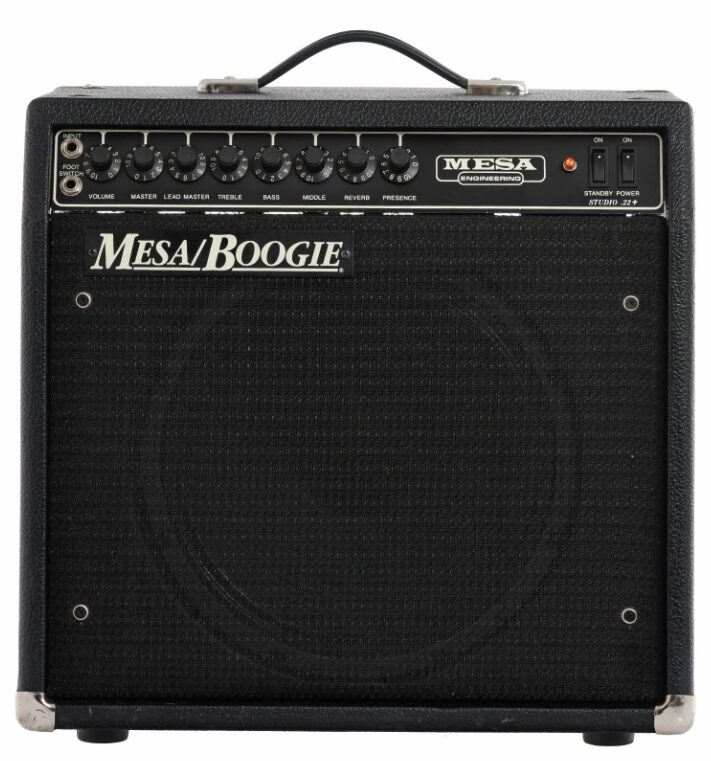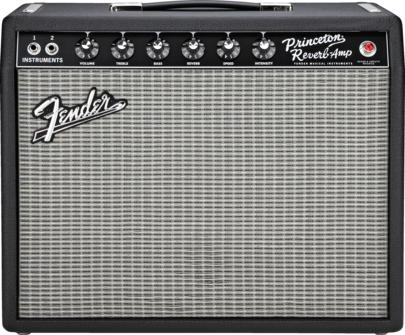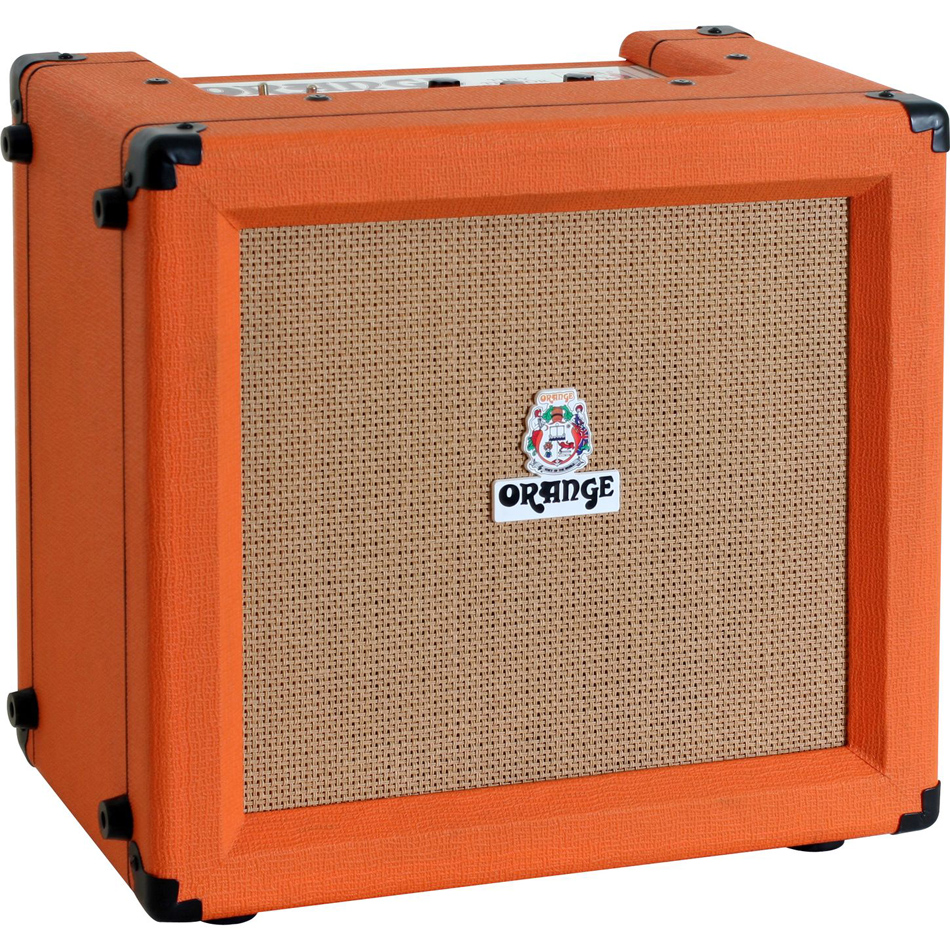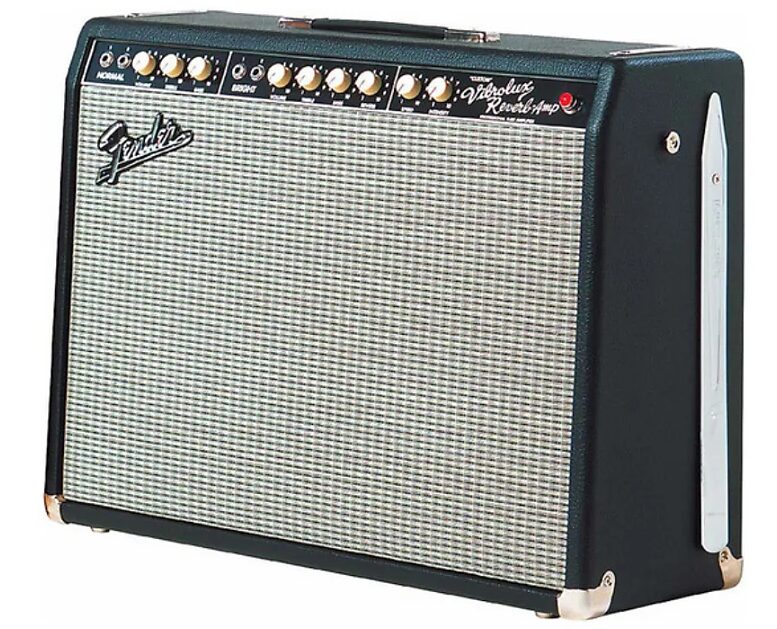The Best Small Tube Amps For The Recording Studio
What are the best small tube amps for the recording studio? See this essential guide:

The Vox Custom AC15C1 amplifier
Buy it new on Sweetwater, B&H, Thomann, or Amazon. Look for deals on Reverb.
There are a lot of benefits to using small amps in the studio: They can give you more and better-sounding gain at a lower-level, they’re easier to swap in and out of a tight corner, they’re less expensive, so you can have more flavors on the same budget, and they’ll often have a uniquely memorable personality and tone.
Remember that in a literal and philosophical sense, recording itself is an illusion. Sounds – the vibrations of molecules in the air – cannot truly be captured and bottled up – only impersonated in another form. Your microphone doesn’t know how big your amp is, it just knows how good the tone sounds. And your VU meter doesn’t know how loud your signal is in absolute terms. It just knows how far you can make it move.
With that in mind, here are some small, classic tube amps that are best-suited for the recording studio. Turn ’em up.

The Mesa Boogie Studio 22 was Kurt Cobain’s guitar amp on Nevermind.
Buy it new on Sweetwater, B&H, Thomann, or Amazon. Look for deals on Reverb.
Signature Models: The Vox AC-15, Mesa Boogie Studio 22, and The Fender Pro Jr
The EL-84 power tube is little brother to the EL-34, the tube found in Marshall and Orange heads. The lower-powered EL-84 is often characterized as having a little bit of the EL-34’s trademark “bite” and mid-range push, but with a little less low bottom and a slightly more supple sound.
The quintessential pint-sized guitar amp that most guitarists are likely to think of first in this family is the classic Vox AC-15, an early favorite of The Beatles. It can deliver anything from Vox’s unmistakable trademark “chime” to a distinctive saturation or gritty crunch.
On the opposite end of the spectrum, there’s the Mesa Boogie Studio 22, the main amp used on Nirvana’s Nevermind. It’s an almost over-designed tube amp with a thick and assertive clean sound, a graphic EQ, and the ability to deliver edgy tones and blistering saturation in an equally convincing way. Currently, a new model of amp occupies this niche in Boogie’s line: The adjustable-watt “Express.”
Small vintage amps from Gibson Epiphone have relied on the tube as well, and today, solid and affordable EL-84 amps are still being churned out by lower-cost brands from Crate to Peavey. They all have their dedicated fans. But the one that takes the top of this list is a relative newcomer and a fast favorite in the studio world: The Fender Pro Jr., which is easily among the most affordable – and coolest-sounding – studio tube amps that company has ever made.
There’s not much to the Pro Jr. Just a handful of tubes, a 10” speaker, and two controls: volume and tone. But this amp is a little devil, known to blow the hair back. At low levels it gives a full-bodied-yet-articulate clean tone; turned up loud, it screams with unexpected authority.
The Jr. doesn’t do extreme overdrive on its own (you’d have to push the front end of it with a pedal to get that) but the tone it does give is endlessly satisfying. Come to think of it, there’s a lot of things the Pro Jr. doesn’t do: reverb, tremolo, EQ. But that doesn’t seem to hold this amp back. So many engineers I know are surprised by just how often it’ll win a shootout against larger amps. I’m one of them.
A slightly larger version, the Blues Jr., packs a little more wattage, a larger 12” speaker that softens some of the Pro Jr.’s bite, and a few extra controls that allow for a decent reverb and a little more preamp gain at low volume levels. But believe it or not, prevailing guitar-amp-snob opinion chooses the ultra-compact Pro Jr. as the winner. If you need a small, affordable, great-sounding foundation for a studio amp collection, this could be just the thing.

Elegant, brilliant, clean: The Fender ’65 Princeton Reverb.
Buy it new on Sweetwater, B&H, Thomann, or Amazon. Look for deals on Reverb.
Signature Models: The Fender Princeton, Fender Deluxe and Fender Champ
The EL-84 was perhaps the most popular choice for compact guitar amplifiers in Britain during the early days of electric guitar. But here in the States, that honor went to the 6V6, which powered some of the best-selling and most-coveted small Fenders in history.
The 6V6 was at the heart of the Fender Champ and Vibro Champ – little powerhouses that just love to be pushed hard. Each model has a bit of its own tone, from the throaty roar of an old tweed champ to the endlessly endearing and almost brittle smack of a silverface Vibro.
The 6V6 was also the foundation of the 22-watt Fender Deluxe, a favorite of Blues wailers and Americana-loving guitar geeks everywhere – A Stevie Ray Vaughan impersonator’s weapon-of-choice and a longtime favorite of Neil Young.
It’s hard to pick one to top the list, but in our book, the amp that stands as a no-brainer choice for most recording studios is the ever-flexible Fender Princeton.
At low enough levels, the Princeton provides an elegant, brilliant clean sound that could fool you for a Fender Twin Reverb. Pushed a bit, it breaks up in a way that is distinctively “Fender”, but perhaps not quite as specific or as identifiable as the Deluxe. And at any setting in between, it can offer a classic-sounding tremolo and a luxurious reverb that’s almost impossible to top.

Orange Tiny Terror
Buy it new on Sweetwater, B&H, Thomann, or Amazon. Look for deals on Reverb.
There are other great options for small studio tube amps. The 6V6 is basically a lower power version of the 6L6 found in many larger American amps like the Twin Reverb and the Fender Bassman. And, although it’s a stretch to consider them truly “small” there are a few small-ish options that use this tube and offer a unique-yet-versatile tone: The Fender Vibrolux and Ampeg Reverberocket come to mind.
Some folks make a great miniature tube amp out of an old portable cinema speaker. The Moviola Mangasync comes to mind. Just install a guitar jack, and you’re good to go.
Some companies offer single-power-tube heads and super-mini combos that put out as little as a couple watts or so. For more on that see VHT, THD, or the Orange “Tiny Terror.” If you’re prepared to live dangerously – and don’t mind putting the longevity of your amp at risk – you can always hook one up to a variac. (But if you blow up your amp, don’t tell your repairman it was our idea.)

Small-ISH: The Fender Vibrolux
Buy it new on Sweetwater, B&H, Thomann, or Amazon. Look for deals on Reverb.
Of course, some people will tell you that amp simulators have come so far that there’s almost no reason to bother getting down and dirty with guitar amps anymore. But even if that is true – and I’m not so certain that it is – which is more inspiring to work with?
Which gives you the feeling of physically and viscerally connecting with your tones? Which option offers more hidden surprises both fun and frustrating; which offers more idiosyncratic variation, a more lasting experience, a greater chance to live in the moment and to make your personal mark in the world?
Until the answer to that changes, I’ll be down on one knee, headphones on, moving the right mic in front of the right amp until it slides right into the sweet spot.
Justin Colletti is a Brooklyn-based audio engineer, college professor, and journalist. He records and mixes all over NYC, masters at JLM, teaches at CUNY, is a regular contributor to SonicScoop, and edits the music blog Trust Me, I’m A Scientist.
For more great insights into both mixing and mastering, try our full-length courses with SonicScoop editor Justin Colletti, Mixing Breakthroughs and Mastering Demystified.
Please note: When you buy products through links on this page, we may earn an affiliate commission.







Jim Santo
March 15, 2013 at 7:23 am (11 years ago)two thumbs up for the Pro Jr., a/k/a “rock in a box”! one of the nicest features is that the little speaker is easily disconnected; run that puppy through a 15″ Clarion speaker for a mind-blowing sound
Ben Jarvis
April 23, 2013 at 7:35 pm (11 years ago)Though not a small amp, I love my Egnater Tweaker 40. Loads of bang for the buck.
7notasestudio
January 31, 2014 at 3:59 pm (10 years ago)I love the Vox and I also have a DIY Marshall 18 watter. The Tiny Terror also features 2 EL84 if I’m not wrong so I’m definitely an EL84 kind of guy. I also like the JCM 800 a lot.
I would like to add that I dont think that the digital emulation is able to replicate the tube amp sound, however if you’re doing demos or something quick software emulation might be right for you.
Great article by the way.
HumbleGuitars
September 15, 2014 at 1:14 pm (10 years ago)Very interesting stuff, i prefer analog recording. I love warmth and feel of a real valve-amp. Digital recording just sounds too digital, I find it dumb to be a guitarist and not having an real amp, instead having some pc software that simulates an real amp.
JB
December 13, 2014 at 1:32 pm (9 years ago)I’ve got a Bassman 20 that’s rated pretty high. Very simple electronics, 18 watts & a 15″ speaker. Mine was featured in a Premiere Guitar article that said under 500 were made. Thanks–JB
Bordô
June 24, 2016 at 11:36 pm (8 years ago)Vox has way to many good options: The Nighttrain, the new AC10 , the AC4 and even the Pathfinder 15r and the Cambridge, both not tube amps, are good options for recording!
Ray Tubes
January 19, 2017 at 8:05 pm (7 years ago)There are lots of “Boutique” low watters out there today offering an amazing palatte of tones.
Using a Variac with an amp should not cause any damage, so long as you do not go higher than 125v, or so low that the tube heaters aren’t getting their 6.3v or a bit cooler.
Running tubes too cold can cause cathode poisining which will only shorten the life of the tubes, and running them on very low voltages, or sending B+ to the grid with no heating may destroy the tube immediately.
That said, a Variac would not create a state such as this.
Vintage amplification and equipment all ran at 115vac, and our line voltage has been creeping up over the years to appx 125vac.
Much of this gear sounds better and will have a longer service life by using a Variac or Variable Regulated Supply to roll the voltage down to 115vac.